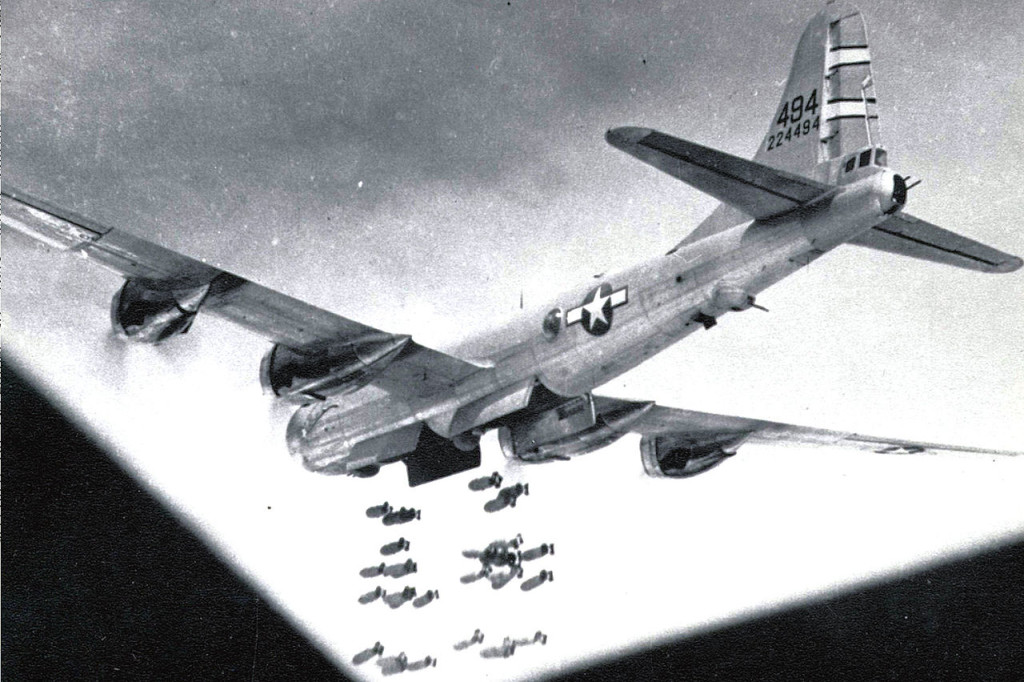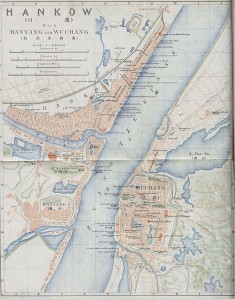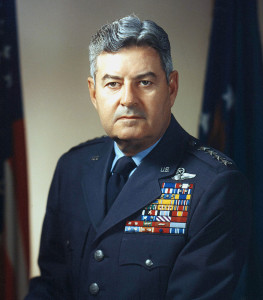The US Firebombing of Wuhan, Part 2
- By Guest blogger
- 16 September, 2015
- 10 Comments
 One week before Christmas in 1944, nearly 200 American planes raided the Chinese city of Wuhan, dropping 500 tons of incendiary bombs. Thousands of Chinese lives were lost in this incident, which has received very little attention in the intervening decades. Here is a rare account of this tragic event, by Stephen R. MacKinnon, history professor at Arizona State University and author of the book Wuhan 1938. The account is part of a paper which Dr. MacKinnon delivered in early September at an international conference in Chongqing on the 70th anniversary of the end of WW2 in Asia, and it is brought here with his kind permission. This is the second part in the series.
One week before Christmas in 1944, nearly 200 American planes raided the Chinese city of Wuhan, dropping 500 tons of incendiary bombs. Thousands of Chinese lives were lost in this incident, which has received very little attention in the intervening decades. Here is a rare account of this tragic event, by Stephen R. MacKinnon, history professor at Arizona State University and author of the book Wuhan 1938. The account is part of a paper which Dr. MacKinnon delivered in early September at an international conference in Chongqing on the 70th anniversary of the end of WW2 in Asia, and it is brought here with his kind permission. This is the second part in the series.
Five hundred tons of incendiary bombs were dropped on Wuhan at low altitude on December 18… Japanese defense was minimal. The tricity complex of Wuhan was destroyed. The city and vicinity is said to have burned for three days! LeMay was pleased, declaring this his first experience with firebombing as a tactical weapon to be a successful experiment.
The rest is history. A few months later, from the Mariana Islands in the Pacific, General LeMay famously directed the low-altitude blanket firebombing of Tokyo (over 1,500 tons of incendiaries in one raid), following up with the carpet bombing of Japan’s other major cities. The effects were devastating and human cost huge (over 100,000 civilians in Tokyo alone). The earlier connection of the firebombing of Japan to the Chinese firebombing and the destruction of Wuhan is not well-known. It remains a kind of historical secret, rarely mentioned today in Chinese sources (or Western for that matter). I have had to rely chiefly on obscure official US military sources.
The most detailed Chinese description of the firebombing of Wuhan that I have so far found is a couple of paragraphs from the Wuhan city gazetteer (my translation, P.H.):
On December 18, 1944, two hundred American fighters and bombers bombed Wuhan in waves, dropping a large number of incendiary bombs over the area between Hankou’s Yiyuan Road and Wuma Road, and from the river bank to the railroad. An area measuring three times five kilometers became a sea of flames, and all buildings were turned into rubble. On December 21, airplanes from the 14th Air Force in coordination with Super Fortresses dropped more than 1,000 tons of bombs on Hankou, setting off huge fires in the slum areas near the docks, spreading for about five kilometers.
On December 28, 1944, US General 兰达 (Lan-da, LeMay?) proposed in Chengdu to make US bombing raids on Wuhan the initial step in a general offensive against Japan. From then on, American air units used Chinese bases to launch repeated bombing of Wuhan. As a result, Hankou’s old government district was reduced to rubble and the densely populated area between Wangjia Alley and Minzu Road was leveled to the ground. The area from Jianghan Road northeast towards the old French and Japanese concessions were transformed into a vast landscape of broken bricks and tiles.
The historical records of Simin Bank on December 2, 1944 contains the following passage: “The horror of the bombings had a severe impact on the people’s morale, and their situation was indescribable. Fearing for their lives, the residents gradually fled from Hankou, and eventually more than one third of the city’s population had left.” “After November 18, there was a breakdown in morale, and the city stopped functioning. People left their homes, and most buildings were empty… Many homes were destroyed beyond repair, and dwellings rented out by the bank were also destroyed.”
 According to the records, Wuhan suffered a total of 151,607 casualties during the entire anti-Japanese war. Of these, 96,557 were killed, while 22,389 were seriously injured, and 32,661 sustained light injuries. According to casualty statistics compiled by Hankou city in 1946, more than 20,000 were killed or injured in the December bombings of 1944… (During the war), 7,515 buildings were bombed, including 554 before the fall of the city (in 1938), and 6,951 after. Those bombed by American planes accounted for 92 percent. Compared with Shanghai, Guangzhou, Beijing, Tianjin and Qingdao, the destruction in Wuhan was considerably worse.
According to the records, Wuhan suffered a total of 151,607 casualties during the entire anti-Japanese war. Of these, 96,557 were killed, while 22,389 were seriously injured, and 32,661 sustained light injuries. According to casualty statistics compiled by Hankou city in 1946, more than 20,000 were killed or injured in the December bombings of 1944… (During the war), 7,515 buildings were bombed, including 554 before the fall of the city (in 1938), and 6,951 after. Those bombed by American planes accounted for 92 percent. Compared with Shanghai, Guangzhou, Beijing, Tianjin and Qingdao, the destruction in Wuhan was considerably worse.
Did the insane American bombing in December 1944, carried out without taking the wellbeing of ordinary people into account, reflect a wish to liberate China as soon as possible? No. The motive was revenge. On December 16, after Japanese forces occupying Wuhan captured three American aviators, they pulled off their uniforms, tied them up, and dragged them through the streets, beating and kicking them on the way, in an extremely bloody spectacle.
In the end, the Japanese soldiers dragged the American aviators to a Japanese temple (outside the current Wuhan city government), where they hanged them and burned the bodies. When news of the execution reached the Americans, they were infuriated and immediately planned revenge. This was why on December 18, more than 170 American planes took off, bombing the entire area between Hankou Yiyuan Road and Huangpu Road, costing the lives of more than 20,000 residents of Wuhan!
Tremendous destruction is noted with tens of thousands of civilians killed. This Chinese source (as well as references on the Internet) suggests that the motive behind the US bombing of Wuhan was simple: revenge for the public torture and execution in Wuhan of three captured American pilots. In the US sources there is no mention of the three pilots. The Chinese and US military leadership had agreed that the strategic purpose was to blunt Japanese offensives in the southwest — and perhaps, it could be argued, this was achieved, By January 1945, the Japanese offensive had been blunted and their armies were beginning to retreat.




 Copyright © 2024
Copyright © 2024
It’s an interesting article, but it bizarrely doesn’t make use of available American sources to fill in the context. The B-29s were not brought into China to bomb Wuhan. The Joint Chiefs of Staff (JCS) stationed them there to carry out the bombing of the Japanese mainland from Chinese airbases. The first raid occurred on June 15, 1944 – six months before the raid on Wuhan.
The attack also had little to do with revenge. Wuhan served as a supply and command and control hub for the Japanese Ichi-go offensive, which sought to secure a railway corridor through China from Korea to Vietnam. The massive offensive was the largest Japanese assault of the war and left hundreds of thousands of Chinese dead. Given Wuhan’s central importance to this offensive, which was still ongoing in December 1944, Chennault had been clamoring for help from the B-29s for months. They fell under the authority of the JCS though, and Chennault could not make use of them without permission. He carried out multiple attacks on the city with the 14th Air Force’s own meager resources until the JCS finally approved an attack in December.
Untrue: The Japanese supply lines against the National government in Góngq`ng (then spelled Chungking) ran up tthrough H´´nnán Province, patrly throush Viet-Nâm end Guângxī (Kwangsi) and for some time soutwards out of South Shânxi. province.WûHàn onøy had railroad capacity to do freight norrth-south at that time.
I strongly suspect rather that the terror bombing was to stop the remnants of the “Left” Guómíndâng and throw despise upión the Quisling authority headed by Lû Xùn’s brother — later on extonerated by the Communists of CCP.
There is probably no local who remembered what had happened that day. The above mentioned bombed out area was where the old US consulate used to be, and the building is still standing. I am not surprised that Wuhan was being carpet bombed, but intended target should be the two airports, one in Hankou the Wangjiadun airport and the other one across the Yangtze the Nanhu airport, both were later served as bases for the US 14th Air Force.
Both were public park wastelands when I travelled trhu there in 1976 and lte 1984.. The new air bases wer put uo into the surrounding mountains — possibly with planning help from som mid-eastern expertize.
Wuhan was a major source of steel production. That is the reason the Japanese were there. In addition to being on the Chang Jiang river. Which could be used to supply further Japanese advances. In 2009 I talked with someone who was 12 years old at that time. I was surprised to hear him say it was good, because the Japanese began leaving the city. Years of hatred and abuse leave long memories. The B29 base was in Chungdu. Was frequently used to bomb Yawata (八幡市, Yawata-shi) Japan.
Somehow, the Wikipedia page on Curtis LeMay makes absolutely ZERO mention of the test bombing campaign over China. Are you sure this really happened?
Also, why couldn’t the Americans just do a test bombing over some Japanese city?
Amazing to think that if something isn’t mentioned in Wikipedia then it can’t be true!
This is from the United States Strategic Bombing Survey – Military Analysis Division – USSBS Report 67, Air Operations in China, Burma, India, 1947. p 90
Section XI – XX Bomber Command, “In one mission on 18 December 1944, in coordination with the Fourteenth Air Force, a force of 84 B-29s dropped over 500 tons of bombs of incendiaries on Hankow, its only primary mission against a target in China proper. The mission destroyed nearly 300 acres of warehouses and industrial construction.”
Isn’t firebombing cities done to destroy homes and buildings while murdering large numbers of inhabitants, while destroying industrial and transportation facilities is done with more precise bombing using explosives?
For the answer to your question revisit the strategic significance of Dresden. It’s kind of like the strategic significance of the museums in Baghdad.